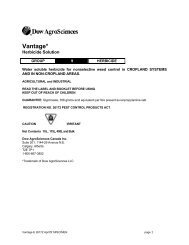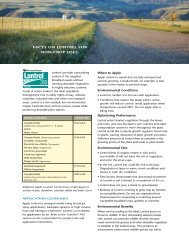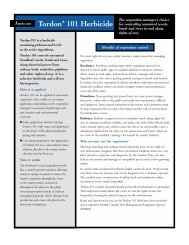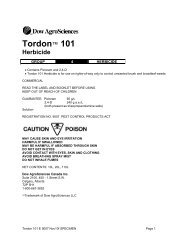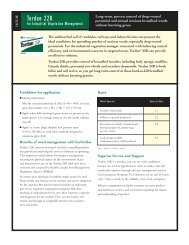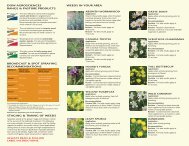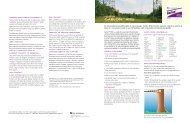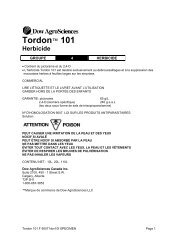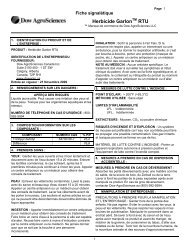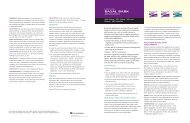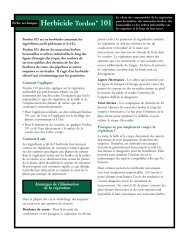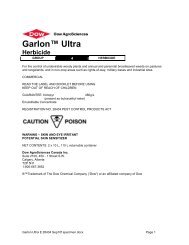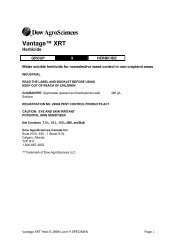Vantage⢠Plus Max II MSDS - True North Specialty Products
Vantage⢠Plus Max II MSDS - True North Specialty Products
Vantage⢠Plus Max II MSDS - True North Specialty Products
Create successful ePaper yourself
Turn your PDF publications into a flip-book with our unique Google optimized e-Paper software.
Material Safety Data Sheet<br />
Dow AgroSciences Canada Inc.<br />
Product Name: Vantage* <strong>Plus</strong> MAX <strong>II</strong> Herbicide Solution Issue Date: 2010.10.25<br />
Dow AgroSciences Canada Inc. encourages and expects you to read and understand the entire<br />
(M)SDS, as there is important information throughout the document. We expect you to follow the<br />
precautions identified in this document unless your use conditions would necessitate other appropriate<br />
methods or actions.<br />
1. Product and Company Identification<br />
Product Name<br />
Vantage* <strong>Plus</strong> MAX <strong>II</strong> Herbicide Solution<br />
COMPANY IDENTIFICATION<br />
Dow AgroSciences Canada Inc.<br />
A Subsidiary of The Dow Chemical Company<br />
Suite 2100, 450 1 st Street SW,<br />
Calgary, AB T2P 5H1<br />
Canada<br />
For <strong>MSDS</strong> updates and Product Information: 800-667-3852<br />
Prepared By:<br />
Prepared for use in Canada by EH&S, Hazard Communications.<br />
Revision 2010.10.25<br />
Customer Information Number: 800-667-3852<br />
solutions@dow.com<br />
EMERGENCY TELEPHONE NUMBER<br />
24-Hour Emergency Contact: 613-996-6666<br />
Local Emergency Contact: 613-996-6666<br />
2. Hazards Identification<br />
Emergency Overview<br />
Color: Yellow<br />
Physical State: Liquid<br />
Odor: Amine.<br />
Hazards of product:<br />
WARNING! May cause allergic skin reaction. May cause eye irritation. Isolate area.<br />
Highly toxic to fish and/or other aquatic organisms.<br />
TM * Trademark of Dow AgroSciences LLC<br />
Page 1 of 7
Product Name: Vantage* <strong>Plus</strong> MAX <strong>II</strong> Herbicide Solution Issue Date: 2010.10.25<br />
Potential Health Effects<br />
Eye Contact: May cause eye irritation. May cause slight corneal injury.<br />
Skin Contact: Brief contact may cause slight skin irritation with local redness.<br />
Skin Absorption: Prolonged skin contact is unlikely to result in absorption of harmful amounts.<br />
Skin Sensitization: Has demonstrated the potential for contact allergy in mice.<br />
Inhalation: No adverse effects are anticipated from single exposure to mist.<br />
Ingestion: Very low toxicity if swallowed. Harmful effects not anticipated from swallowing small<br />
amounts.<br />
Birth Defects/Developmental Effects: For similar active ingredient(s). Glyphosate. Has been toxic<br />
to the fetus in laboratory animals at doses toxic to the mother.<br />
Reproductive Effects: For similar active ingredient(s). Glyphosate. In laboratory animal studies,<br />
effects on reproduction have been seen only at doses that produced significant toxicity to the parent<br />
animals.<br />
3. Composition/information on ingredients<br />
Component CAS # Amount<br />
W/W<br />
Glyphosate DMA Salt 34494-04-7 50.2 %<br />
Balance 49.8 %<br />
Amounts are presented as percentages by weight.<br />
4. First-aid measures<br />
Eye Contact: Hold eyes open and rinse slowly and gently with water for 15-20 minutes. Remove<br />
contact lenses, if present, after the first 5 minutes, then continue rinsing eyes. Call a poison control<br />
center or doctor for treatment advice.<br />
Skin Contact: Take off contaminated clothing. Wash skin with soap and plenty of water for 15-20<br />
minutes. Call a poison control center or doctor for treatment advice. Wash clothing before reuse.<br />
Shoes and other leather items which cannot be decontaminated should be disposed of properly.<br />
Inhalation: Move person to fresh air. If person is not breathing, call an emergency responder or<br />
ambulance, then give artificial respiration; if by mouth to mouth use rescuer protection (pocket mask<br />
etc). Call a poison control center or doctor for treatment advice.<br />
Ingestion: No emergency medical treatment necessary.<br />
Notes to Physician: No specific antidote. Treatment of exposure should be directed at the control of<br />
symptoms and the clinical condition of the patient.<br />
5. Fire Fighting Measures<br />
Extinguishing Media: To extinguish combustible residues of this product use water fog, carbon<br />
dioxide, dry chemical or foam.<br />
Fire Fighting Procedures: Keep people away. Isolate fire and deny unnecessary entry. Use water<br />
spray to cool fire exposed containers and fire affected zone until fire is out and danger of reignition has<br />
passed. To extinguish combustible residues of this product use water fog, carbon dioxide, dry<br />
chemical or foam. Contain fire water run-off if possible. Fire water run-off, if not contained, may cause<br />
environmental damage. Review the “Accidental Release Measures” and the “Ecological Information”<br />
sections of this (M)SDS.<br />
Special Protective Equipment for Firefighters: Wear positive-pressure self-contained breathing<br />
apparatus (SCBA) and protective fire fighting clothing (includes fire fighting helmet, coat, trousers,<br />
boots, and gloves). Avoid contact with this material during fire fighting operations. If contact is likely,<br />
change to full chemical resistant fire fighting clothing with self-contained breathing apparatus. If this is<br />
not available, wear full chemical resistant clothing with self-contained breathing apparatus and fight fire<br />
Page 2 of 7
Product Name: Vantage* <strong>Plus</strong> MAX <strong>II</strong> Herbicide Solution Issue Date: 2010.10.25<br />
from a remote location. For protective equipment in post-fire or non-fire clean-up situations, refer to<br />
the relevant sections.<br />
Unusual Fire and Explosion Hazards: This material will not burn until the water has evaporated.<br />
Residue can burn. If exposed to fire from another source and water is evaporated, exposure to high<br />
temperatures may cause toxic fumes. Dense smoke is produced when product burns.<br />
Hazardous Combustion <strong>Products</strong>: During a fire, smoke may contain the original material in addition<br />
to combustion products of varying composition which may be toxic and/or irritating. Combustion<br />
products may include and are not limited to: Phosphorus oxides. Nitrogen oxides. Carbon monoxide.<br />
Carbon dioxide.<br />
See Section 9 for related Physical Properties<br />
6. Accidental Release Measures<br />
Steps to be Taken if Material is Released or Spilled: Contain spilled material if possible. Small<br />
spills: Absorb with materials such as: Clay. Dirt. Sand. Sweep up. Collect in suitable and properly<br />
labeled containers. Large spills: Contact Dow AgroSciences for clean-up assistance. See Section<br />
13, Disposal Considerations, for additional information.<br />
Personal Precautions: Isolate area. Keep unnecessary and unprotected personnel from entering the<br />
area. Refer to Section 7, Handling, for additional precautionary measures. Use appropriate safety<br />
equipment. For additional information, refer to Section 8, Exposure Controls and Personal Protection.<br />
Environmental Precautions: Prevent from entering into soil, ditches, sewers, waterways and/or<br />
groundwater. See Section 12, Ecological Information.<br />
7. Handling and Storage<br />
Handling<br />
General Handling: Keep out of reach of children. Do not swallow. Avoid breathing vapor or mist.<br />
Avoid contact with eyes, skin, and clothing. Use with adequate ventilation. Wash thoroughly after<br />
handling.<br />
Storage<br />
Do not store in: Galvanized containers. Unlined steel containers. Store in a dry place. Store in<br />
original container. Keep container tightly closed when not in use. Do not store near food, foodstuffs,<br />
drugs or potable water supplies.<br />
8. Exposure Controls / Personal Protection<br />
Exposure Limits<br />
Consult local authorities for recommended exposure limits.<br />
RECOMMENDATIONS IN THIS SECTION ARE FOR MANUFACTURING, COMMERCIAL<br />
BLENDING AND PACKAGING WORKERS. APPLICATORS AND HANDLERS SHOULD SEE THE<br />
PRODUCT LABEL FOR PROPER PERSONAL PROTECTIVE EQUIPMENT AND CLOTHING.<br />
None established<br />
Personal Protection<br />
Eye/Face Protection: Use chemical goggles.<br />
Skin Protection: Use protective clothing chemically resistant to this material. Selection of specific<br />
items such as face shield, boots, apron, or full body suit will depend on the task. Remove<br />
contaminated clothing immediately, wash skin area with soap and water, and launder clothing before<br />
reuse or dispose of properly. Items which cannot be decontaminated, such as shoes, belts and<br />
watchbands, should be removed and disposed of properly.<br />
Hand protection: Use gloves chemically resistant to this material. Examples of preferred<br />
glove barrier materials include: Chlorinated polyethylene. Polyethylene. Ethyl vinyl alcohol<br />
laminate (“EVAL”). Examples of acceptable glove barrier materials include: Butyl rubber.<br />
Natural rubber (“latex”). Neoprene. Nitrile/butadiene rubber (“nitrile” or “NBR”). Polyvinyl<br />
chloride (“PVC” or “vinyl”). Viton. Avoid gloves made of: Polyvinyl alcohol (“PVA”). NOTICE:<br />
Page 3 of 7
Product Name: Vantage* <strong>Plus</strong> MAX <strong>II</strong> Herbicide Solution Issue Date: 2010.10.25<br />
The selection of a specific glove for a particular application and duration of use in a workplace<br />
should also take into account all relevant workplace factors such as, but not limited to: Other<br />
chemicals which may be handled, physical requirements (cut/puncture protection, dexterity,<br />
thermal protection), potential body reactions to glove materials, as well as the<br />
instructions/specifications provided by the glove supplier.<br />
Respiratory Protection: Respiratory protection should be worn when there is a potential to exceed<br />
the exposure limit requirements or guidelines. If there are no applicable exposure limit requirements<br />
or guidelines, wear respiratory protection when adverse effects, such as respiratory irritation or<br />
discomfort have been experienced, or where indicated by your risk assessment process. For most<br />
conditions no respiratory protection should be needed; however, if discomfort is experienced, use an<br />
approved air-purifying respirator. The following should be effective types of air-purifying respirators:<br />
Organic vapor cartridge with a particulate pre-filter.<br />
Ingestion: Use good personal hygiene. Do not consume or store food in the work area. Wash hands<br />
before smoking or eating.<br />
Engineering Controls<br />
Ventilation: Use local exhaust ventilation, or other engineering controls to maintain airborne levels<br />
below exposure limit requirements or guidelines. If there are no applicable exposure limit<br />
requirements or guidelines, general ventilation should be sufficient for most operations. Local exhaust<br />
ventilation may be necessary for some operations.<br />
9. Physical and Chemical Properties<br />
Physical State<br />
Color<br />
Odor<br />
Odor Threshold<br />
Flash Point - Closed Cup<br />
Flammable Limits In Air<br />
Autoignition Temperature<br />
Vapor Pressure<br />
Boiling Point (760 mmHg)<br />
Vapor Density (air = 1)<br />
Specific Gravity (H2O = 1)<br />
Liquid Density<br />
Freezing Point<br />
Melting Point<br />
Solubility in water (by<br />
weight)<br />
pH<br />
Decomposition<br />
Temperature<br />
Evaporation Rate (Butyl No test data available<br />
Acetate = 1)<br />
Dynamic Viscosity 62.3 mPa.s @ 20 °C<br />
Kinematic Viscosity No test data available<br />
Liquid<br />
Yellow<br />
Amine<br />
No test data available<br />
Not applicable<br />
Lower: No test data available<br />
Upper: No test data available<br />
No test data available<br />
Not applicable<br />
No test data available<br />
Not applicable<br />
1.2114 Digital Density Meter (Oscillating Coil)<br />
1.2114 g/cm3 @ 20 °C Digital density meter<br />
No test data available<br />
Not applicable<br />
Soluble<br />
4.59 (@ 1 %) pH Electrode 1% aqueous solution.<br />
No test data available<br />
10. Stability and Reactivity<br />
Stability/Instability<br />
Thermally stable at typical use temperatures.<br />
Conditions to Avoid: Active ingredient decomposes at elevated temperatures. Generation of gas<br />
during decomposition can cause pressure in closed systems.<br />
Incompatible Materials: Avoid contact with: Acids. Halogens. Oxidizers. Peroxides. Flammable<br />
hydrogen may be generated from contact with metals such as:<br />
Page 4 of 7
Product Name: Vantage* <strong>Plus</strong> MAX <strong>II</strong> Herbicide Solution Issue Date: 2010.10.25<br />
Hazardous Polymerization<br />
Will not occur.<br />
Thermal Decomposition<br />
Decomposition products depend upon temperature, air supply and the presence of other materials.<br />
Decomposition products can include and are not limited to: Carbon monoxide. Carbon dioxide.<br />
Amines. Hydrocarbons. Nitrogen oxides. Phosphorus oxides. Toxic gases are released during<br />
decomposition.<br />
11. Toxicological Information<br />
Acute Toxicity<br />
Ingestion<br />
LD50, Rat, female > 5,000 mg/kg<br />
Dermal<br />
LD50, Rat, male and female > 5,000 mg/kg<br />
Inhalation<br />
LC50, 4 h, Aerosol, Rat, male and female > 5.63 mg/l<br />
Eye damage/eye irritation<br />
May cause eye irritation. May cause slight corneal injury.<br />
Skin corrosion/irritation<br />
Brief contact may cause slight skin irritation with local redness.<br />
Sensitization<br />
Skin<br />
Has demonstrated the potential for contact allergy in mice.<br />
Repeated Dose Toxicity<br />
Based largely or completely on information for similar material(s). Glyphosate. Based on available<br />
data, repeated exposures are not anticipated to cause significant adverse effects.<br />
Chronic Toxicity and Carcinogenicity<br />
For similar active ingredient(s). Glyphosate. Did not cause cancer in laboratory animals.<br />
Developmental Toxicity<br />
For similar active ingredient(s). Glyphosate. Has been toxic to the fetus in laboratory animals at<br />
doses toxic to the mother. For similar active ingredient(s). Did not cause birth defects in laboratory<br />
animals.<br />
Reproductive Toxicity<br />
For similar active ingredient(s). Glyphosate. In laboratory animal studies, effects on reproduction<br />
have been seen only at doses that produced significant toxicity to the parent animals.<br />
Genetic Toxicology<br />
This material was not mutagenic in an Ames bacterial assay. The following information is based on<br />
limited data and/or screening studies. Animal genetic toxicity studies were negative.<br />
12. Ecological Information<br />
ENVIRONMENTAL FATE<br />
Data for Component: Glyphosate DMA Salt<br />
Movement & Partitioning<br />
For similar active ingredient(s). Glyphosate. Bioconcentration potential is low (BCF less than<br />
100 or log Pow less than 3). Potential for mobility in soil is slight (Koc between 2000 and<br />
5000).<br />
Persistence and Degradability<br />
For similar active ingredient(s). Glyphosate. Biodegradation may occur under aerobic<br />
conditions (in the presence of oxygen).<br />
Page 5 of 7
Product Name: Vantage* <strong>Plus</strong> MAX <strong>II</strong> Herbicide Solution Issue Date: 2010.10.25<br />
ECOTOXICITY<br />
Material is highly toxic to aquatic organisms on an acute basis (LC50/EC50 between 0.1 and 1 mg/L in<br />
the most sensitive species tested). Material is practically non-toxic to birds on an acute basis (LD50 ><br />
2000 mg/kg).<br />
Fish Acute & Prolonged Toxicity<br />
LC50, rainbow trout (Oncorhynchus mykiss), static, 96 h: 11 mg/l<br />
Aquatic Invertebrate Acute Toxicity<br />
EC50, water flea Daphnia magna, static, 48 h, survival: 17 mg/l<br />
Aquatic Plant Toxicity<br />
EbC50, green alga Pseudokirchneriella subcapitata (formerly known as Selenastrum capricornutum),<br />
static, biomass growth inhibition, 72 h: 0.99 mg/l<br />
ErC50, green alga Pseudokirchneriella subcapitata (formerly known as Selenastrum capricornutum),<br />
static, Growth rate inhibition, 72 h: 2.1 mg/l<br />
Toxicity to Above Ground Organisms<br />
oral LD50, Japanese quail (Coturnix coturnix japonica): > 2250 mg/kg bw/day<br />
LD50, Honey bee (Apis mellifera): > 250 ug/bee<br />
contact LD50, Honey bee (Apis mellifera): > 250 ug/bee<br />
Toxicity to Soil Dwelling Organisms<br />
LC50, Earthworm Eisenia foetida, adult, 14 d: > 996.6 mg/kg<br />
13. Disposal Considerations<br />
If wastes and/or containers cannot be disposed of according to the product label directions, disposal of<br />
this material must be in accordance with your local or area regulatory authorities. This information<br />
presented below only applies to the material as supplied. The identification based on characteristic(s)<br />
or listing may not apply if the material has been used or otherwise contaminated. It is the<br />
responsibility of the waste generator to determine the toxicity and physical properties of the material<br />
generated to determine the proper waste identification and disposal methods in compliance with<br />
applicable regulations. If the material as supplied becomes a waste, follow all applicable regional,<br />
national and local laws.<br />
14. Transport Information<br />
TDG Small container<br />
NOT REGULATED<br />
TDG Large container<br />
NOT REGULATED<br />
IMDG<br />
Proper Shipping Name: ENVIRONMENTALLY HAZARDOUS SUBSTANCE, LIQUID, N.O.S.<br />
Technical Name: Glyphosate<br />
Hazard Class: 9 ID Number: UN3082 Packing Group: PG <strong>II</strong>I<br />
EMS Number: F-A,S-F<br />
Marine pollutant.: Yes<br />
ICAO/IATA<br />
Proper Shipping Name: ENVIRONMENTALLY HAZARDOUS SUBSTANCE, LIQUID, N.O.S.<br />
Technical Name: Glyphosate<br />
Hazard Class: 9 ID Number: UN 3082 Packing Group: PG <strong>II</strong>I<br />
Cargo Packing Instruction: 914<br />
Passenger Packing Instruction: 914<br />
Page 6 of 7
Product Name: Vantage* <strong>Plus</strong> MAX <strong>II</strong> Herbicide Solution Issue Date: 2010.10.25<br />
15. Regulatory Information<br />
CEPA - Domestic Substances List (DSL)<br />
All substances contained in this product are listed on the Canadian Domestic Substances List (DSL) or<br />
are not required to be listed.<br />
Hazardous <strong>Products</strong> Act Information: CPR Compliance<br />
This product has been classified in accordance with the hazard criteria of the Canadian Controlled<br />
<strong>Products</strong> Regulations (CPR) and the <strong>MSDS</strong> contains all the information required by the CPR.<br />
Hazardous <strong>Products</strong> Act Information: WHMIS Classification<br />
This product is exempt under WHMIS.<br />
Pest Control <strong>Products</strong> Act Registration number: 28840<br />
National Fire Code of Canada<br />
Not applicable<br />
16. Other Information<br />
Hazard Rating System<br />
NFPA Health Fire Reactivity<br />
1 0 0<br />
Recommended Uses and Restrictions<br />
Product use: End use herbicide product<br />
Revision<br />
Identification Number: 1007605 / 1023 / Issue Date 2010.10.25 / Version: 1.3<br />
DAS Code: GF-1280<br />
Most recent revision(s) are noted by the bold, double bars in left-hand margin throughout this<br />
document.<br />
Legend<br />
N/A<br />
Not available<br />
W/W<br />
Weight/Weight<br />
OEL<br />
Occupational Exposure Limit<br />
STEL Short Term Exposure Limit<br />
TWA<br />
Time Weighted Average<br />
ACGIH American Conference of Governmental Industrial Hygienists, Inc.<br />
DOW IHG Dow Industrial Hygiene Guideline<br />
WEEL Workplace Environmental Exposure Level<br />
HAZ_DES Hazard Designation<br />
VOL/VOL Volume/Volume<br />
Dow AgroSciences Canada Inc. urges each customer or recipient of this (M)SDS to study it carefully<br />
and consult appropriate expertise, as necessary or appropriate, to become aware of and understand<br />
the data contained in this (M)SDS and any hazards associated with the product. The information<br />
herein is provided in good faith and believed to be accurate as of the effective date shown above.<br />
However, no warranty, express or implied, is given. Regulatory requirements are subject to change<br />
and may differ between various locations. It is the buyer’s/user’s responsibility to ensure that his<br />
activities comply with all federal, state, provincial or local laws. The information presented here<br />
pertains only to the product as shipped. Since conditions for use of the product are not under the<br />
control of the manufacturer, it is the buyer’s/user’s duty to determine the conditions necessary for the<br />
safe use of this product. Due to the proliferation of sources for information such as manufacturerspecific<br />
(M)SDSs, we are not and cannot be responsible for (M)SDSs obtained from any source other<br />
than ourselves. If you have obtained an (M)SDS from another source or if you are not sure that the<br />
(M)SDS you have is current, please contact us for the most current version.<br />
Page 7 of 7



